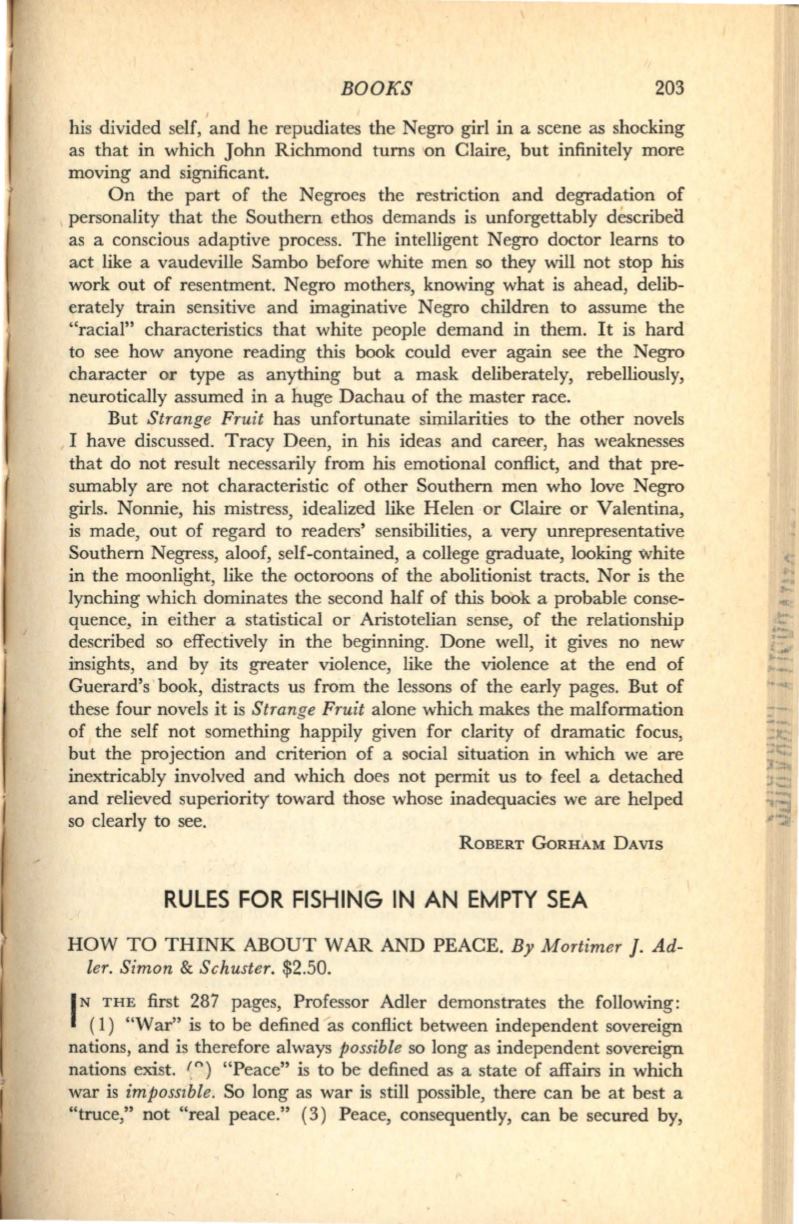
BOOKS
203
his divided self, and he repudiates the Negro girl in a scene as shocking
as that in which John Richmond turns on Claire, but infinitely more
moving and significant.
On the part of the Negroes the restriction and degradation of
personality that the Southern ethos demands is unforgettably describea
as a conscious adaptive process. The intelligent Negro doctor learns to
act like a vaudeville Sambo before white men so they will not stop his
work out of resentment. Negro mothers, knowing what is ahead, delib–
erately train sensitive and imaginative Negro children to assume the
"racial" characteristics that white people demand in them. It is hard
to see how anyone reading this book could ever again see the Negro
character or type as anything but a mask deliberately, rebelliously,
neurotically assumed in a huge Dachau of the master race.
But
Strange Fruit
has unfortunate similarities to the other novels
I have discussed. Tracy Deen, in his ideas and career, has weaknesses
that do not result necessarily from his emotional conflict, and that pre–
sumably are not characteristic of other Southern men who love Negro
girls. Nonnie, his mistress, idealized like Helen or Claire or Valentina,
is made, out of regard to readers' sensibilities, a very unrepresentative
Southern Negress, aloof, self-contained, a college graduate, looking white
in the moonlight, like the octoroons of the abolitionist tracts. Nor is the
lynching which dominates the second half of this book a probable conse–
quence, in either a statistical or Aristotelian sense, of the relationship
described so effectively in the beginning. Done well, it gives no new
insights, and by its greater violence, like the violence at the end of
Guerard's ·book, distracts us from the lessons of the early pages. But of
these four novels it is
Strange Fruit
alone which makes the malformation
of the self not something happily given for clarity of dramatic focus,
but the projection and criterion of a social situation in which we are
inextricably involved and which does not permit us to feel a detached
and relieved superiority toward those whose inadequacies we are helped
so clearly to see.
RoBERT GoRHAM DAVIs
RULES FOR FISHING IN AN EMPTY SEA
HOW TO THINK ABOUT WAR AND PEACE.
By Mortimer
f.
Ad-
ler. Simon
&
Schuster.
$2.50.
I
N THE
first 287 pages, Professor Adler demonstrates the following:
( 1) "War" is to be defined as conflict between independent sovereign
nations, and is therefore always
possible
so long as independent sovereign
nations exist.
f")
"Peace" is to be defined as a state of
affairs
in which
war is
imposszble.
So long as war is still possible, there can be at best a
"truce," not "real peace." (3) Peace, consequently, can be secured by,


